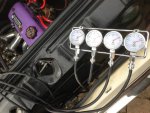I have tried a lot of things to get my Weber DCOE's tuned right. They are on an R17 TS. The problem is surging between 2000 rpm and 3000 rpm, and poor idle. I have read many pages of stuff on the Web and my thought is that the carbs I have, have only have two progression holes. There are a number of people I know who have given up and fitted a down draft Weber saying it is too hard on these motors. I have heard that people have got carbs with two holes working and yes so can I if I make the idle jets and idle screw rich and probably if I try and drop the rpm when the mains come in with an appropriate emulsion tube, air corrector etc. But this is at the expense of top end performance, a big cloud of black smoke on acceleration, and higher than normal fuel consumption.
I need to point out for those that are not aware, the idle jet also supplies the progression holes. They provide the fuel until the mains come in normally from 2,800 rpm to about 3,200 rpm. 3200 rpm is 100 kph so there is a lot of driving done on just progression holes. Just to complicate matters the accelerator pump allows fuel to flow not only during hard acceleration but during normal running. There is a document on Renault engines with these carbs that translates to "if progression isn't right then poor idle and progression will result".
Now 1600 cc Alpine 110, 310, and presumably R12 G have 3 progression holes except for very early carbs. The general consensus is don't try and drill additional holes unless you are a professional. It is essential that any additional hole is the correct size and in the correct location. But Alfa's have the same problem and drilling an additional hole solves it for them. Ford Zetec have 4 holes but run smoother with 5.
So does any one have the correct carbs and can they tell me the size and location of the progression holes or am I talking crap.
The correct carbs are No. 29 and 30, or 36 and 37, or 38 and 39,or 62 and 63. Note they are not pairs as one carb has and air corrector screw for one cylinder to get it to balance. Apparently a problem, as I was told by a mechanic from the R16 rally team that different emulsion tubes were used in the rear cylinder to get it balanced. Incidentally they seemed to be reasonably smooth when I had them on my R12G replica using the same jets, emulsion tubes etc.
I need to point out for those that are not aware, the idle jet also supplies the progression holes. They provide the fuel until the mains come in normally from 2,800 rpm to about 3,200 rpm. 3200 rpm is 100 kph so there is a lot of driving done on just progression holes. Just to complicate matters the accelerator pump allows fuel to flow not only during hard acceleration but during normal running. There is a document on Renault engines with these carbs that translates to "if progression isn't right then poor idle and progression will result".
Now 1600 cc Alpine 110, 310, and presumably R12 G have 3 progression holes except for very early carbs. The general consensus is don't try and drill additional holes unless you are a professional. It is essential that any additional hole is the correct size and in the correct location. But Alfa's have the same problem and drilling an additional hole solves it for them. Ford Zetec have 4 holes but run smoother with 5.
So does any one have the correct carbs and can they tell me the size and location of the progression holes or am I talking crap.
The correct carbs are No. 29 and 30, or 36 and 37, or 38 and 39,or 62 and 63. Note they are not pairs as one carb has and air corrector screw for one cylinder to get it to balance. Apparently a problem, as I was told by a mechanic from the R16 rally team that different emulsion tubes were used in the rear cylinder to get it balanced. Incidentally they seemed to be reasonably smooth when I had them on my R12G replica using the same jets, emulsion tubes etc.


 Brendan. p.s Does Iain Stewart still run his carbie business in Brisbane? Font of knowledge. Murray Coote, Ohlins distributor, maybe of help to get in contact. Murray is based in Brisbane and a Peugeot tragic in the best sense.
Brendan. p.s Does Iain Stewart still run his carbie business in Brisbane? Font of knowledge. Murray Coote, Ohlins distributor, maybe of help to get in contact. Murray is based in Brisbane and a Peugeot tragic in the best sense.


